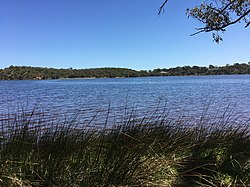Canning River
River in Perth, Western Australia From Wikipedia, the free encyclopedia
The Canning River (Nyungar: Djarlgarra[2][3] or Nyungar: Dyarlgarro[4]) is a major tributary of the Swan River in the South West Land Division of Western Australia. It is home to much wildlife including dolphins, pelicans, swans and many other bird species.
| Canning River Nyungar: Djarlgarra | |
|---|---|
 Canning River from southern shore looking north towards Mount Henry overlooking Aquinas Bay | |
 | |
| Location | |
| Country | Australia |
| State | Western Australia |
| City | Perth |
| Physical characteristics | |
| Source | |
| • location | Wandering[1] |
| Mouth | Swan River |
• location | Melville Water |
• coordinates | 32°00′11″S 115°51′02″E |
| Length | 110 km (68 mi) |
| Basin features | |
| Tributaries | |
| • left | Bull Creek, Bannister Creek, Lambertia Creek, Southern River, Churchmans Brook |
| • right | Yule Brook, Bickley Brook, Ellis Brook, Stoney Brook, Stinton Creek |
Source and route
With headwaters on the Darling Scarp, the Canning meanders through suburbs of Perth on the Swan Coastal Plain, including Cannington, Thornlie, Riverton, Shelley, Rossmoyne and Mount Pleasant, before joining the Swan at Melville Water just downstream of the Canning Bridge.[5]
Bridges
- Canning Bridge
- Mount Henry Bridge
- Shelley Bridge
- Riverton Bridge
- Kent Street Weir Bridge
- Greenfield Street Bridge
- Canning River Downstream Bridge
- Canning River Upstream Bridge
- Djarlgarra Bridge Easthbound
- Djarlgarra Bridge Westbound
- unnamed railway bridge
- Royal Street Bridge
- unnamed pedestrian bridge
- Burslem Bridge
- unnamed railway bridge
- Jenna Biddi Footbridge
- unnamed railway bridge
- unnamed pedestrian bridge
- Cargeeg Bridge
- unnamed road bridge
- Manning Road Footbridge
Points
- Coffee Point (east of Point Heathcote on the Swan River)
- Deepwater Point (on western shore in Mount Pleasant)
- Salter Point (very narrow part of river between Salter Point suburb on north side, Rossmoyne/Shelley border on south)
- Prisoner Point (south shore in Shelley suburb, east of Shelley Beach)
- Wadjup Point (north west of Shelley Bridge)
History
The first European contact was in 1801[6] when a French exploring party spotted the mouth. The crew subsequently named the mouth Entrée Moreau[6] after Charles Moreau, a midshipman with the party.
The Canning River received its contemporary name in 1827 when Captain James Stirling aboard HMS Success following an examination of the region in March 1827 named the river after George Canning,[6] an eminent British statesman who was Prime Minister of Great Britain at the time and whose government facilitated the funds for the expedition.
In November 1829, just five months after the founding of the Swan River Colony, an exploring party led by now Governor James Stirling chose a site for a new town named Kelmscott[7] on the banks of the Canning River.
Convicts

Convicts partly constructed and maintained the Canning River Convict Fence.[8][9][10][11][12] This structure is still a notable landmark to this day. It was built primarily for the use of barges carrying timber from Mason's Timber Mill in the Darling Ranges.
Algae bloom
Algal blooms occur naturally in the Canning River system; they are caused by a buildup of nutrients in the river. Human activities including farming, residential gardens and parklands are the major causes of increases in levels; the blooms are potentially toxic to both mammal and marine life. The Swan River Trust monitors the levels of nutrients and growth of the algae, issuing warnings and closing sections of the river to all activities. The Trust also operates cleanup programs to reduce the amount of nutrients reaching the river, as well phosphorus removal and oxygenation in areas were blooms have been identified.[13]
The Trust is encouraged by the appearance of Azolla carpets on sections of the Canning River as this fern is known to reduce the amount of sunlight available to the algae as well as absorbing large amounts of phosphorus and other nutrients from the water. However, it is possible that Azolla carpets can cause deoxygenation and emit a strong sulphur smell.[14]
- Canning River without Azolla in February 2006
- Same location covered in a carpet of Azolla in March 2007
See also
References
Further reading
Wikiwand - on
Seamless Wikipedia browsing. On steroids.




